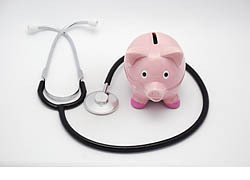Health-care costs continue to rise, but there are things you can do to help make your health insurance more affordable.
With unemployment high and overall wealth down, it can be tempting to cut your health insurance in an effort to save money. Don’t. According to a recent study from Harvard University, 62 percent of all personal bankruptcies are due to medical expenses. The good news is that there are a number of steps you can take to make your health insurance more affordable.
Shop around
Even if you have group health insurance through your employer, you may find an individual health insurance plan to be less expensive. Group plans provide a broad range of coverage because they are covering a diverse set of consumers. With an individual health insurance plan, you have more flexibility in selecting a plan that best fits your health-care needs.
Stay healthy.
Eat right and exercise more. Being obese can increase average yearly health-care costs by as much as $395. The better your body-mass index (BMI), the better rate you can receive.
Stop smoking.
Many health insurers pay for smoking-cessation programs. After being smoke-free for a certain period of time—usually a year—notify your health insurer to receive a reduction in your premiums.
Review your health insurance plan’s rules.
You could end up paying more for your health care if you don’t follow the rules. Double-check with your insurer’s customer service department to find out if the provider or care you need is covered before you receive treatment; also find out if you need any authorizations before proceeding.
Raise your deductible or copay.
Determine if you’re willing or able to pay more out-of-pocket. If you are, raising your deductible or copay amount will lower your monthly premiums.
Switch to a high-deductible health plan.
High-deductible health plans (HDHPs) are meant to cover major medical expenses. The plan’s high deductible equals lower premium costs. Depending on the plan, preventive care may not be covered until you meet your deductible. If you’re young and healthy, an HDHP could be a smart choice.
Pair your HDHP with a health savings account.
If you choose a deductible of at least $1,200 for single coverage or $2,400 for family coverage, you can contribute to a health savings account, or HSA. HSA contributions are tax-deductible, as are withdrawals used for qualified medical expenses. You can contribute up to $3,050 a year ($6,150 for family coverage) to an HSA. If you withdraw funds to pay for non-medical expenses before the age of 65, however, you will have to pay income tax and possibly a 10 percent penalty.
Know your medical history. You insurer does.
Details about your medical past (for the past seven years) are shared between insurers through the Medical Information Bureau (MIB). Check your medical history report just as you would your credit report to make sure there aren’t any mistakes in your file. Visit MIB yearly to receive a free copy of your medical report.
Keep your insurer informed about changes to your health status.
Have you lost weight in the past year? Quit smoking? Have your diabetes under control? Let your insurer know if your health status has changed and explain how you are keeping any chronic illnesses under control.
Save on prescriptions.

- Switch to generic drugs.
- Ask your doctor for free samples.
- Check your neighborhood pharmacies such as Wal-Mart and Target for a list of generic drugs they offer at low, flat-rate prices. (Some are as low as $4!)
- Contact the drug manufacturer to see what financial assistance programs they offer. You may qualify if you have no presciption insurance, are unable to afford your medication or meet low-income guidelines.
Reassess your health insurance needs on a regular basis.
Your health status or health-care needs may have changed since you originally signed up for your health insurance plan. Review what your current plan offers and compare that to the type of health care you need now.
Negotiate with your doctor.
The Healthcare Blue Book enables you to look up the rate insurance companies have negotiated for numerous medical procedures. Ask your doctor to honor this rate.
Related Articles
- Resources For Seniors
- Increase Your Social Security Benefits
- Managing Your Aging Parents Finances
- Find Out Your Healtcare Costs
- Purchasing Individual Health Insurance: What you need to know
- Prescription Insurance
- HMO Insurance
- Do You Need Long Term Care Insurance?
- Why You Need Long Term Disability Insurance
- Do You Need Medicare Part D Insurance?
- Pick The Medicare Part D Plan That's Right For You!
- Medicare Prescription Drug Coverage
- Medigap Supplemental Insurance Explained
- Supplemental Insurance - What Is It?
- Medical Marijuana - Should Marijuana Be a Medical Option?
- Prescription Drugs - Should They Be Advertised to Consumers?
- Pet Insurance: Do You Need It?
 Print
Print Email
Email








